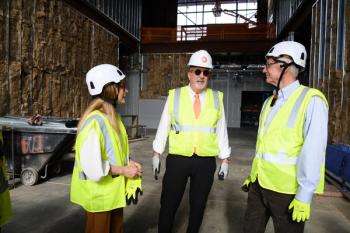
Dream in green
Take these five earth-friendly steps to minimize building costs, energy usage, and toxic materials in your facility.
Forty percent of the energy consumed worldwide is directly linked to either fabrication and construction of materials, actual building construction, or building operation and utilities, according to Worldwatch Institute, a nonprofit environmental research institute, says Mark Hafen, AIA, a senior partner with Animal Arts/Gates Hafen Cochrane in Boulder, Colo. And every building makes a difference. Consider these issues as you craft your dream practice, and make your hospital a responsible member of society.
1. Use natural light. "Incorporate natural day lighting and ventilation in the building to reduce electrical lighting, and heating and ventilation requirements," says Hafen. For example, consider using high windows over cages, in the pharmacy, above cabinets, and in other areas to let light in. And use interior windows to let the light spread further into the practice. Interior glass walls also help to maximize borrowed light. "I worked on a hospital with surgery rooms facing into a glass-walled atrium," Hafen says. "The doctors got a nice view and the benefit of the natural light."
2. Orient your practice to minimize heat load from the sun. "You gain the most heat on your west wall," says Hafen, "not your south wall. So you're actually better off to position your building with long dimension running east/west versus north/south." Hafen recommends putting overhangs above windows to the south to keep the high summer sun from coming in. That way, in the winter, the sun will drop down to give you natural light.
3. Minimize storm runoff. Reduce asphalt paving where you can. And consider alternative products, such as porous asphalt that lets water drop through it, says Hafen. "You install a gravel bed underneath the asphalt for storm-water retention." Another possibility: cellular paving, patterned concrete blocks with holes that grass can grow through. "You can drive across it," he says, "but it absorbs water just like a lawn." This could be a good option for fire access roads and overflow parking, Hafen says.
4. Conserve energy. If you reduce utility use, you save energy—and money. Hafen suggests these options:
- Increase insulation in walls to R-20 and in roofs to R-40.
- Use insulated and tinted glass to reduce heat gain into buildings.
- Incorporate an economizer function into your rooftop mechanical unit so on temperate days you can bring outside air inside without heating or cooling it.
- Use a heat-recovery system—an air-to-air heat exchanger—to precondition the air being brought into the building.
5. Use smart lighting solutions. First, use photosensitive and/or occupancy-sensing switch-on lighting. Then reduce incandescent lighting, and use high-efficiency T-8 fluorescent lighting with electronic ballasts wherever possible. "Compact fluorescent lights save energy. And full-spectrum fluorescent lighting is much better for people and pets," says Dr. Michelle Chappell, owner of Dogtor's Day Off Veterinary Relief Services, who's building a green hospital in Overland Park, Kan.
Newsletter
From exam room tips to practice management insights, get trusted veterinary news delivered straight to your inbox—subscribe to dvm360.




